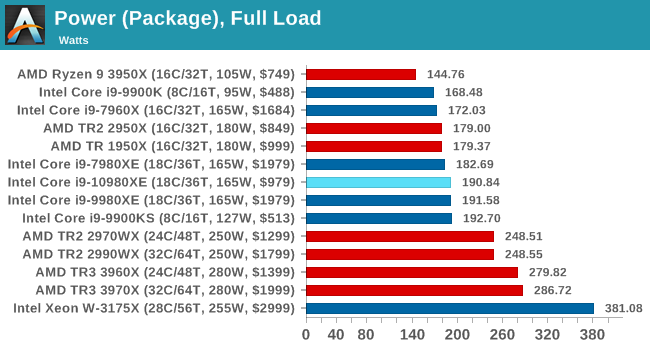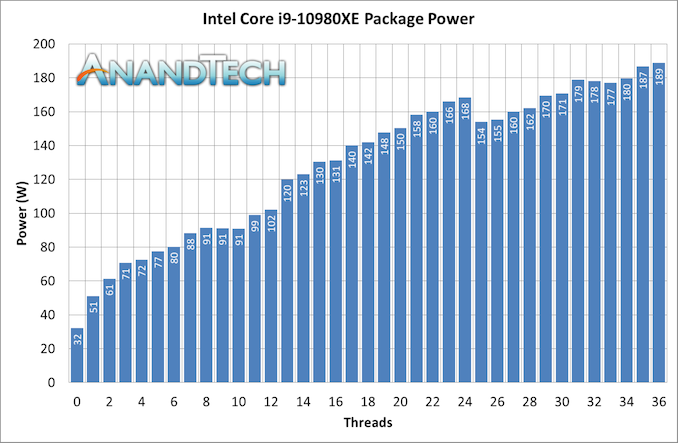It’s a Cascade of 14nm CPUs: AnandTech’s Intel Core i9-10980XE Review
by Dr. Ian Cutress on November 25, 2019 9:00 AM ESTPower Consumption
We’ve covered in detail across multiple articles the story of Intel’s turbo: about how the TDP on the box doesn’t mean a whole lot, the motherboard you’re using can ultimately determine how long your CPU does turbo for, and how the power limits of the processor are ultimately decided by the motherboard manufacturer’s settings in the BIOS unless you change them. Intel only gives recommendations on peak turbo power and the length of the turbo: the only thing Intel defines is the peak frequency based on load when turbo is allowed.
Talking Intel’s TDP and Turbo
Interviewing an Intel Fellow about TDP and Turbo
Comparing Turbo: AMD and Intel
This means that an extremely conservative system might not allow the power to go above TDP, but the system capable of all the power might allow the processor to turbo ad infinitum. The reality is usually somewhere in the middle, but for a high-end desktop platform, where most of the motherboards are engineered to withstand almost anything that comes at it, we’re going to often see the situation of an elongated or persistent turbo.
It’s worth noting that for consumer workloads, most of the work can happen within a reasonable turbo – and thus sustained performance metrics aren’t that important. But today we are testing high-end desktop hardware, and because Intel doesn’t explicitly define peak turbo power or turbo length (it only provides recommendations that motherboard manufacturers can and do ignore), I obviously asked Intel what it believes that reviewers should do when trying to compare performance. The answer wasn’t very helpful: test with a range of motherboards’.
In our previous review of the Core i9-9900KS, I did two sets of tests: benchmarks at the motherboard default, and tests at the Intel recommended turbo settings. The motherboard defaults, for that motherboard in question, were essentially full turbo all the time. Intel’s recommended settings gave some decreases in the long benchmarks, around 7%, but the rest of the tests were about the same.
For this review, we’re using ASRock’s X299 OC Formula motherboard. This is a motherboard designed for high-end and extreme overclocking, and is built accordingly. As a result, our sustained turbo and power limits are set very high. This is a HEDT system, and most HEDT motherboards are built and engineered this way, and so we expect our results here to be consummate with most users’ performance.
For our power consumption metrics, Intel actually does some obfuscation on its high-end platform. Unlike AMD, we cannot extract the per-core power numbers from the internal registers during a sustained workload. As a result, all we get are total package numbers, which show the cooling requirements of the processor but also include the power consumption of the DRAM controller, uncore, and PCIe root complexes.
The TDP of this chip is 165 W – normally Intel recommends a peak power of 1.25x, which would be 207 W, and so the 189 W value we see is under this. The chip we got is technically an engineering sample, not a retail part, although we usually expect the final stepping engineering samples to be identical to what is sold in the market. Despite this, your mileage may vary.
When we compare this peak to other CPUs:












79 Comments
View All Comments
Korguz - Wednesday, November 27, 2019 - link
ever think that maybe they cant ??sarafino - Friday, January 10, 2020 - link
My guess is that the vast majority of people willing to pay for a Threadripper motherboard, especially a TR4 board, went for the higher core count TR CPU's. I wouldn't be surprised if it was a case of AMD deciding not to waste money on making such low volume SKU.umano - Wednesday, November 27, 2019 - link
I don't think that 10nm intel in 2021 will match or beat amd ryzen 5000. If they will match ryzen 4000 I'd say it's a miracleballsystemlord - Wednesday, November 27, 2019 - link
What happened to the 10980XE in the y-Cruncher MT test?hoohoo - Thursday, November 28, 2019 - link
@Ian - your price chart are misleading: you are using retail price for AMD and wholesale (ie per 1000 units) price for Intel.The 10980XE will retail with a markup, it will cost 25 or 30 percent higher than the $979 you are using here.
ballsystemlord - Thursday, November 28, 2019 - link
He can't be certain what the markup will be, so he's using the tray prices. Not that I recommend that, but it's about as fair as he can be for the time being.NetMage - Thursday, November 28, 2019 - link
"and so we expect our results here to be consummate with most users’ performance" - I certainly hope not. Perhaps you meant "commensurate"?Gonemad - Friday, November 29, 2019 - link
Tiny typo... Sub $1k sheet.:DRAM Capacity 256GB vs. 128MB.
Everybody know memories are in the 128GB order of magnitude... but... yeah... GB or MB?
'Cause we are never sure these days.
- Nitpicking.
sharath.naik - Thursday, December 19, 2019 - link
Message for intel, the only people who are willing to upgrade are those who already invested in the x299 lga2066 socket motherboards. So when you release a 10nm make sure you release at least one on LGA2066 socket. I am done with Intel if they go after the money and do one more socket change to annoy those who stuck with intel despite their stale processes. For it will make more sense to just move to AMD if you need to buy a new motherboard anyway, Atleast they will support the socket for a few generations of CPUs